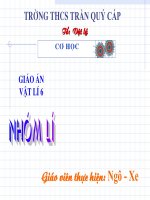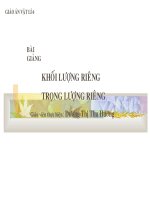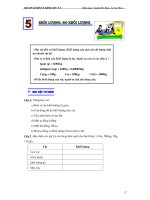ASTM C 127 Khối lượng riêng, độ hút nước cốt liệu
Bạn đang xem bản rút gọn của tài liệu. Xem và tải ngay bản đầy đủ của tài liệu tại đây (62.39 KB, 6 trang )
Designation: C 127 – 01
Standard Test Method for
Density, Relative Density (Specific Gravity), and Absorption
of Coarse Aggregate1
This standard is issued under the fixed designation C 127; the number immediately following the designation indicates the year of
original adoption or, in the case of revision, the year of last revision. A number in parentheses indicates the year of last reapproval. A
superscript epsilon (e) indicates an editorial change since the last revision or reapproval.
This standard has been approved for use by agencies of the Department of Defense.
bility of regulatory limitations prior to use.
1. Scope *
1.1 This test method covers the determination of the average
density of a quantity of coarse aggregate particles (not including the volume of voids between the particles), the relative
density (specific gravity), and the absorption of the coarse
aggregate. Depending on the procedure used, the density
(kg/m3(lb/ft3)) is expressed as oven-dry (OD), saturatedsurface-dry (SSD), or as apparent density. Likewise, relative
density (specific gravity), a dimensionless quantity, is expressed as OD, SSD, or as apparent relative density (apparent
specific gravity). The OD density and OD relative density are
determined after drying the aggregate. The SSD density, SSD
relative density, and absorption are determined after soaking
the aggregate in water for a prescribed duration.
1.2 This test method is used to determine the density of the
essentially solid portion of a large number of aggregate
particles and provides an average value representing the
sample. Distinction is made between the density of aggregate
particles as determined by this test method, and the bulk
density of aggregates as determined by Test Method C 29/
C 29M, which includes the volume of voids between the
particles of aggregates.
1.3 This test method is not intended to be used with
lightweight aggregates.
1.4 The values stated in SI units are to be regarded as the
standard for conducting the tests. The test results for density
shall be reported in either SI units or inch-pound units, as
appropriate for the use to be made of the results.
1.5 The text of this test method references notes and
footnotes which provide explanatory material. These notes and
footnotes (excluding those in tables and figures) shall not be
considered as requirements of this test method.
1.6 This standard does not purport to address all of the
safety concerns, if any, associated with its use. It is the
responsibility of the user of this standard to establish appropriate safety and health practices and determine the applica-
2. Referenced Documents
2.1 ASTM Standards:
C 29/C 29M Test Method for Bulk Density (“Unit Weight”)
and Voids in Aggregate2
C 125 Terminology Relating to Concrete and Concrete
Aggregates2
C 128 Test Method for Density, Relative Density (Specific
Gravity), and Absorption of Fine Aggregate2
C 136 Test Method for Sieve Analysis of Fine and Coarse
Aggregates2
C 566 Test Method for Total Evaporable Moisture Content
of Aggregate by Drying2
C 670 Practice for Preparing Precision and Bias Statements
for Test Methods for Construction Materials2
C 702 Practice for Reducing Samples of Aggregate to
Testing Size2
D 75 Practice for Sampling Aggregates3
D 448 Classification for Sizes of Aggregate for Road and
Bridge Construction3
E 11 Specification for Wire Cloth and Sieves for Testing
Purposes4
2.2 AASHTO Standard:
AASHTO No. T 85 Specific Gravity and Absorption of
Coarse Aggregate5
3. Terminology
3.1 Definitions:
3.1.1 absorption, n—the increase in mass of aggregate due
to water penetration into the pores of the particles during a
prescribed period of time, but not including water adhering to
the outside surface of the particles, expressed as a percentage
of the dry mass.
3.1.2 oven-dry (OD), adj—related to aggregate particles,
the condition in which the aggregates have been dried by
1
This test method is under the jurisdiction of ASTM Committee C09 on
Concrete and Concrete Aggregates and is the direct responsibility of Subcommittee
C09.20 on Normal Weight Aggregates.
Current edition approved Aug. 10, 2001. Published October 2001. Originally
published as C 127 – 36 T. Last previous edition C 127 – 88 (2001).
2
Annual Book of ASTM Standards, Vol 04.02.
Annual Book of ASTM Standards, Vol 04.03.
4
Annual Book of ASTM Standards, Vol 14.02.
5
Available from American Association of State Highway and Transportation
Officials, 444 North Capitol St. N.W., Suite 225, Washington, DC 20001.
3
*A Summary of Changes section appears at the end of this standard.
Copyright © ASTM, 100 Barr Harbor Drive, West Conshohocken, PA 19428-2959, United States.
1
C 127
heating in an oven at 110 6 5°C for sufficient time to reach a
constant mass.
3.1.3 saturated-surface-dry (SSD), adj—related to aggregate particles, the condition in which the permeable pores of
aggregate particle are filled with water to the extent achieved
by submerging in water for the prescribed period of time, but
without free water on the surface of the particles.
3.1.4 density, n—the mass per unit volume of a material,
expressed as kilograms per cubic metre (pounds per cubic
foot).
3.1.4.1 density (OD), n—the mass of oven dry aggregate per
unit volume of aggregate particles, including the volume of
permeable and impermeable pores within the particles, but not
including the voids between the particles.
3.1.4.2 density (SSD), n—the mass of saturated-surface-dry
aggregate per unit volume of the aggregate particles, including
the volume of impermeable pores and water-filled voids within
the particles, but not including the pores between the particles.
3.1.4.3 apparent density, n—the mass per unit volume of the
impermeable portion of the aggregate particles.
3.1.5 relative density (specific gravity), n—the ratio of the
density of a material to the density of distilled water at a stated
temperature; the values are dimensionless.
3.1.5.1 relative density (specific gravity) (OD), n—the ratio
of the density (OD) of the aggregate to the density of distilled
water at a stated temperature.
3.1.5.2 relative density (specific gravity) (SSD), n—the ratio
of the density (SSD) of the aggregate to the density of distilled
water at a stated temperature.
3.1.5.3 apparent relative density (apparent specific gravity),
n—the ratio of the apparent density of aggregate to the density
of distilled water at a stated temperature.
3.1.6 For definitions of other terms related to aggregates,
see Terminology C 125.
5.2 Apparent density and apparent relative density (apparent
specific gravity) pertain to the solid material making up the
constituent particles not including the pore space within the
particles which is accessible to water.
5.3 Absorption values are used to calculate the change in the
mass of an aggregate due to water absorbed in the pore spaces
within the constituent particles, compared to the dry condition,
when it is deemed that the aggregate has been in contact with
water long enough to satisfy most of the absorption potential.
The laboratory standard for absorption is that obtained after
submerging dry aggregate for a prescribed period of time.
Aggregates mined from below the water table commonly have
a moisture content greater than the absorption determined by
this test method, if used without opportunity to dry prior to use.
Conversely, some aggregates which have not been continuously maintained in a moist condition until used are likely to
contain an amount of absorbed moisture less than the 24-h
soaked condition. For an aggregate that has been in contact
with water and that has free moisture on the particle surfaces,
the percentage of free moisture is determined by deducting the
absorption from the total moisture content determined by Test
Method C 566.
5.4 The general procedures described in this test method are
suitable for determining the absorption of aggregates that have
had conditioning other than the 24-h soak, such as boiling
water or vacuum saturation. The values obtained for absorption
by other test methods will be different than the values obtained
by the prescribed soaking, as will the relative density (specific
gravity) (SSD).
5.5 The pores in lightweight aggregates are not necessarily
filled with water after immersion for 24 h. In fact, the
absorption potential for many such aggregates is not satisfied
after several days’ immersion in water. Therefore, this test
method is not intended for use with lightweight aggregate.
4. Summary of Test Method
4.1 A sample of aggregate is immersed in water for 24 6 4
h to essentially fill the pores. It is then removed from the water,
the water dried from the surface of the particles, and the mass
determined. Subsequently, the volume of the sample is determined by the displacement of water method. Finally, the
sample is oven-dried and the mass determined. Using the mass
values thus obtained and formulas in this test method, it is
possible to calculate density, relative density (specific gravity),
and absorption.
6. Apparatus
6.1 Balance—A device for determining mass that is sensitive, readable, and accurate to 0.05 % of the sample mass at
any point within the range used for this test, or 0.5 g,
whichever is greater. The balance shall be equipped with
suitable apparatus for suspending the sample container in water
from the center of the platform or pan of the balance.
6.2 Sample Container—A wire basket of 3.35 mm (No. 6)
or finer mesh, or a bucket of approximately equal breadth and
height, with a capacity of 4 to 7 L for 37.5-mm (11⁄2-in.)
nominal maximum size aggregate or smaller, and a larger
container as needed for testing larger maximum size aggregate.
The container shall be constructed so as to prevent trapping air
when the container is submerged.
6.3 Water Tank—A watertight tank into which the sample
container is placed while suspended below the balance.
6.4 Sieves—A 4.75-mm (No. 4) sieve or other sizes as
needed (see 7.2-7.4), conforming to Specification E 11.
5. Significance and Use
5.1 Relative density (specific gravity) is the characteristic
generally used for calculation of the volume occupied by the
aggregate in various mixtures containing aggregate, including
portland cement concrete, bituminous concrete, and other
mixtures that are proportioned or analyzed on an absolute
volume basis. Relative density (specific gravity) is also used in
the computation of voids in aggregate in Test Method C 29/
C 29M. Relative density (specific gravity) (SSD) is used if the
aggregate is wet, that is, if its absorption has been satisfied.
Conversely, the relative density (specific gravity) (OD) is used
for computations when the aggregate is dry or assumed to be
dry.
7. Sampling
7.1 Sample the aggregate in accordance with Practice D 75.
7.2 Thoroughly mix the sample of aggregate and reduce it to
the approximate quantity needed using the applicable procedures in Practice C 702. Reject all material passing a 4.75-mm
2
C 127
(No. 4) sieve by dry sieving and thoroughly washing to remove
dust or other coatings from the surface. If the coarse aggregate
contains a substantial quantity of material finer than the
4.75-mm sieve (such as for Size No. 8 and 9 aggregates in
Classification D 448), use the 2.36-mm (No. 8) sieve in place
of the 4.75-mm sieve. Alternatively, separate the material finer
than the 4.75-mm sieve and test the finer material according to
Test Method C 128.
NOTE 3—Values for absorption and relative density (specific gravity)
(SSD) may be significantly higher for aggregate not oven dried before
soaking than for the same aggregate treated in accordance with 8.1. This
is especially true of particles larger than 75 mm since the water may not
be able to penetrate the pores to the center of the particle in the prescribed
soaking period.
8.3 Remove the test sample from the water and roll it in a
large absorbent cloth until all visible films of water are
removed. Wipe the larger particles individually. A moving
stream of air is permitted to assist in the drying operation. Take
care to avoid evaporation of water from aggregate pores during
the surface-drying operation. Determine the mass of the test
sample in the saturated surface-dry condition. Record this and
all subsequent masses to the nearest 0.5 g or 0.05 % of the
sample mass, whichever is greater.
8.4 After determining the mass in air, immediately place the
saturated-surface-dry test sample in the sample container and
determine its apparent mass in water at 23 6 2.0°C. Take care
to remove all entrapped air before determining its mass by
shaking the container while immersed.
NOTE 1—If aggregates smaller than 4.75 mm (No. 4) are used in the
sample, check to ensure that the size of the openings in the sample
container is smaller than the minimum size aggregate.
7.3 The minimum mass of test sample to be used is given as
follows. Testing the coarse aggregate in several size fractions is
permited. If the sample contains more than 15 % retained on
the 37.5-mm (11⁄2-in.) sieve, test the material larger than 37.5
mm in one or more size fractions separately from the smaller
size fractions. When an aggregate is tested in separate size
fractions, the minimum mass of test sample for each fraction
shall be the difference between the masses prescribed for the
maximum and minimum sizes of the fraction.
Nominal Maximum Size,
mm (in.)
12.5 (1⁄2) or less
19.0 (3⁄4)
25.0 (1)
37.5 (11⁄2)
50 (2)
63 (21⁄2)
75 (3)
90 (31⁄2)
100 (4)
125 (5)
NOTE 4—The difference between the mass in air and the mass when the
sample is submerged in water equals the mass of water displaced by the
sample.
NOTE 5—The container should be immersed to a depth sufficient to
cover it and the test sample while determining the apparent mass in water.
Wire suspending the container should be of the smallest practical size to
minimize any possible effects of a variable immersed length.
Minimum Mass of Test
Sample, kg (lb)
2 (4.4)
3 (6.6)
4 (8.8)
5 (11)
8 (18)
12 (26)
18 (40)
25 (55)
40 (88)
75 (165)
8.5 Dry the test sample to constant mass at a temperature of
110 6 5°C, cool in air at room temperature 1 to 3 h, or until the
aggregate has cooled to a temperature that is comfortable to
handle (approximately 50°C), and determine the mass.
7.4 If the sample is tested in two or more size fractions,
determine the grading of the sample in accordance with Test
Method C 136, including the sieves used for separating the size
fractions for the determinations in this method. In calculating
the percentage of material in each size fraction, ignore the
quantity of material finer than the 4.75-mm (No. 4) sieve (or
2.36-mm (No. 8) sieve when that sieve is used in accordance
with 7.2).
9. Calculations
9.1 Relative Density (Specific Gravity):
9.1.1 Relative Density (Specific Gravity) (OD)—Calculate
the relative density (specific gravity) on the basis of oven-dry
aggregate as follows:
Relative density ~specific gravity! ~OD! 5 A/~B 2 C!
(1)
where:
A = mass of oven-dry test sample in air, g,
B = mass of saturated-surface-dry test sample in air, g, and
C = apparent mass of saturated test sample in water, g.
9.1.2 Relative Density (Specific Gravity) (SSD)—Calculate
the relative density (specific gravity) on the basis of saturatedsurface-dry aggregate as follows:
NOTE 2—When testing coarse aggregate of large nominal maximum
size requiring large test samples, it may be more convenient to perform the
test on two or more subsamples, and the values obtained combined for the
computations described in Section 9.
8. Procedure
8.1 Dry the test sample to constant mass at a temperature of
110 6 5°C, cool in air at room temperature for 1 to 3 h for test
samples of 37.5-mm (11⁄2-in.) nominal maximum size, or
longer for larger sizes until the aggregate has cooled to a
temperature that is comfortable to handle (approximately
50°C). Subsequently immerse the aggregate in water at room
temperature for a period of 24 6 4 h.
8.2 Where the absorption and relative density (specific
gravity) values are to be used in proportioning concrete
mixtures in which the aggregates will be in their naturally
moist condition, the requirement in 8.1 for initial drying is
optional, and, if the surfaces of the particles in the sample have
been kept continuously wet until tested, the requirement in 8.1
for 24 6 4 h soaking is also optional.
Relative density ~specific gravity! ~SSD! 5 B/~B 2 C!
(2)
9.1.3 Apparent Relative Density (Apparent Specific
Gravity)—Calculate the apparent relative density (apparent
specific gravity) as follows:
Apparent relative density ~apparent specific gravity! 5 A/~A 2 C!
(3)
9.2 Density:
9.2.1 Density (OD)—Calculate the density on the basis of
oven-dry aggregate as follows:
3
Density ~OD!, kg/m3, 5 997.5 A/~B 2 C!
(4)
Density ~OD!, lb/ft3, 5 62.27 A/~B 2 C!
(5)
C 127
10. Report
10.1 Report density results to the nearest 10 kg/m3, or 0.5
lb/ft3, relative density (specific gravity) results to the nearest
0.01, and and indicate the basis for density or relative density
(specific gravity), as either (OD), (SSD), or apparent.
10.2 Report the absorption result to the nearest 0.1 %.
10.3 If the density, relative density (specific gravity) and
absorption values were determined without first drying the
aggregate, as permitted in 8.2, note that fact in the report.
NOTE 6—The constant values used in the calculations in 9.2.1-9.2.3
(997.5 kg/m3 and 62.27 lb/ft3) are the density of water at 23°C.
9.2.2 Density (SSD)—Calculate the density on the basis of
saturated-surface-dry aggregate as follows:
Density ~SSD!, kg/m3, 5 997.5 B/~B 2 C!
(6)
Density ~SSD!, lb/ft3, 5 62.27 B/~B 2 C!
(7)
9.2.3 Apparent Density—Calculate the apparent density as
follows:
Apparent density, kg/m3 5 997.5 A/~A2 C!
(8)
Apparent density, lb/ft3 562.27 A/~A2 C!
(9)
11. Precision and Bias
11.1 The estimates of precision of this test method listed in
Table 1 are based on results from the AASHTO Materials
Reference Laboratory Proficiency Sample Program, with testing conducted by this test method and AASHTO Method T 85.
The significant difference between the methods is that Test
Method C 127 requires a saturation period of 24 6 4 h, while
Method T 85 requires a saturation period of 15 h minimum.
This difference has been found to have an insignificant effect
on the precision indices. The data are based on the analyses of
more than 100 paired test results from 40 to 100 laboratories.
The precision estimates for density were calculated from
values determined for relative density (specific gravity), using
the density of water at 23°C for the conversion.
11.2 Bias—Since there is no accepted reference material for
determining the bias for the procedure in this test method, no
statement on bias is being made.
9.3 Average Density and Relative Density (Specific Gravity)
Values—When the sample is tested in separate size fractions,
compute the average values for density or relative density
(specific gravity) of the size fraction computed in accordance
with 9.1 or 9.2 using the following equation:
G5
1
P1
P2
Pn ~see Appendix X1!
1
1
...
100 G1
100 G2
100 Gn
(10)
where:
G
= average density or relative density (specific
gravity). All forms of expression of density
or relative density (specific gravity) can be
averaged in this manner,
G1, G2... Gn = appropriate average density or relative density (specific gravity) values for each size
fraction depending on the type of density or
relative density (specific gravity) being averaged, and
P1, P2, ... Pn = mass percentages of each size fraction
present in the original sample (not including finer material—see 7.4).
9.4 Absorption—Calculate the percentage of absorption, as
follows:
Absorption, % 5 @~B 2 A!/A# 3 100
12. Keywords
12.1 absorption; aggregate; apparent density; apparent relative density; coarse aggregate; density; relative density; specific gravity
TABLE 1 Precision
Standard Deviation Acceptable Range of
(1s)A
Two Results (d2s)A
Single-Operator Precision:
Density (OD), kg/m3
Density (SSD), kg/m3
Apparent density, kg/m3
Relative density (specific gravity)
(OD)
Relative density (specific gravity)
(SSD)
Apparent relative density (apparent
specific gravity)
(11)
NOTE 7—Some authorities recommend using the density of water at
4°C (1000 kg/m3 or 1.000 Mg/m3 or 62.43 lb/ft 3) as being sufficiently
accurate.
9.5 Average Absorption Value—When the sample is tested
in separate size fractions, the average absorption value is the
average of the values as computed in 9.4, weighted in
proportion to the mass percentages of each size fraction present
in the original sample (not including finer material—see 7.4) as
follows:
A 5 ~P 1A1/100! 1 ~P2A2/100! 1 ... ~PnAn/100!
where:
A
A1, A2... An
P1, P2, ... Pn
Multilaboratory Precision:
Density (OD), kg/m3
Density (SSD), kg/m3
Apparent density, kg/m3
Relative density (specific gravity)
(OD)
Relative density (specific gravity)
(SSD)
Apparent relative density (apparent
specific gravity)
(12)
= average absorption, %,
= absorption percentages for each size fraction, and
= mass percentages of each size fraction
present in the original sample.
9
7
7
0.009
25
20
20
0.025
0.007
0.020
0.007
0.020
13
11
11
0.013
38
32
32
0.038
0.011
0.032
0.011
0.032
A
These numbers represent, respectively, the (1s) and (d2s) limits as described
in Practice C 670. The precision estimates were obtained from the analysis of
combined AASHTO Materials Reference Laboratory proficiency sample data from
laboratories using 15 h minimum saturation times and other laboratories using 24
6 4 h saturation times. Testing was performed on normal-weight aggregates, and
started with aggregates in the oven-dry condition.
4
C 127
APPENDIXES
(Nonmandatory Information)
X1. DEVELOPMENT OF EQUATIONS
X1.1 The derivation of the equation is from the following
simplified cases using two solids. Solid 1 has a mass M1 in
grams and a volume V1 in millilitres; its relative density
(specific gravity) (G1) is therefore M1/V1. Solid 2 has a mass
M2 and volume V2, and G2 = M2/V2. If the two solids are
considered together, the relative density (specific gravity) of
the combination is the total mass in grams divided by the total
volume in millilitres:
G 5 ~ M 1 1 M 2 ! / ~ V1 1 V 2 !
Therefore,
1
G5 P 1
P2 1
1
100 G1 1 100 G2
(X1.6)
An example of the computation is given in Table X1.1.
(X1.1)
Manipulation of this equation yields the following:
1
1
G5 V 1V 5
V1
V2
1
2
M1 1 M 2
M1 1 M 2 1 M1 1 M 2
G5
S D
M1
V1
M1 1 M2 M1
1
(X1.2)
S D
(X1.3)
V2
M2
1M 1M M
1
2
2
However, the mass fractions of the two solids are:
M1/~M1 1 M 2! 5 P1/100 and M 2/~M1 1 M2! 5 P 2/100
(X1.4)
1/G1 5 V1/M1 and 1/G2 5 V2/M 2
(X1.5)
and,
TABLE X1.1 Example of Calculation of Weighted Values of
Relative Density (Specific Gravity) and Absorption for a Coarse
Aggregate Tested in Separate Sizes
Size
Fraction, mm (in.)
4.75 to 12.5
(No. 4 to 1⁄2)
12.5 to 37.5
(1⁄2 to 11⁄2)
37.5 to 63
(11⁄2 to 21⁄2)
% in
Original
Sample
Sample Mass
Used in Test, g
Relative
Density
(Specific
Gravity)
(SSD)
Absorption,
%
44
2213.0
2.72
0.4
35
5462.5
2.56
2.5
21
12593.0
2.54
3.0
Average Relative Density (Specific Gravity) (SSD)
1
0.35
0.21 5 2.62
1
1
2.72
2.56
2.54
GSSD 5 0.44
Average Absorption
A 5 ~0.44! ~0.4! 1 ~0.35! ~2.5! 1 ~0.21! ~3.0! 5 1.7 %
X2. INTERRELATIONSHIPS BETWEEN RELATIVE DENSITIES (SPECIFIC GRAVITIES) AND ABSORPTION AS DEFINED
IN TEST METHODS C 127 AND C 128
X2.1 Where:
Sd = relative density (specific gravity) (OD),
5
C 127
Sd
1
Sa 5 1
A 5
AS d
1 2 100
Sd 2 100
Ss = relative density (specific gravity) (SSD),
Sa = apparent relative density (apparent specific gravity),
and
A = absorption in %.
1
Sa 5 1 1 A/100
Ss
X2.2 Calculate the values of each as follows:
Ss 5 ~1 1 A/100!S d
(X2.1)
Ss
A
A 5
2 100
1 2 100 ~Ss 2 1!
S
D
F
(X2.2)
G
Ss
A 5 S 2 1 100
d
(X2.4)
Sa 2 Ss
Sa ~S s 2 1!
(X2.5)
A5
S
D
100
SUMMARY OF CHANGES
This section identifies the location of changes to this test method that have been incorporated since the last
issue.
(1) Section 1 was revised.
(2) Section 2 was updated.
(3) Sections 3 through 11 were revised.
(4) The Appendix was revised.
(5) All tables were revised.
The American Society for Testing and Materials takes no position respecting the validity of any patent rights asserted in connection
with any item mentioned in this standard. Users of this standard are expressly advised that determination of the validity of any such
patent rights, and the risk of infringement of such rights, are entirely their own responsibility.
This standard is subject to revision at any time by the responsible technical committee and must be reviewed every five years and
if not revised, either reapproved or withdrawn. Your comments are invited either for revision of this standard or for additional standards
and should be addressed to ASTM Headquarters. Your comments will receive careful consideration at a meeting of the responsible
technical committee, which you may attend. If you feel that your comments have not received a fair hearing you should make your
views known to the ASTM Committee on Standards, at the address shown below.
This standard is copyrighted by ASTM, 100 Barr Harbor Drive, PO Box C700, West Conshohocken, PA 19428-2959, United States.
Individual reprints (single or multiple copies) of this standard may be obtained by contacting ASTM at the above address or at
610-832-9585 (phone), 610-832-9555 (fax), or (e-mail); or through the ASTM website (www.astm.org).
6
(X2.3)









